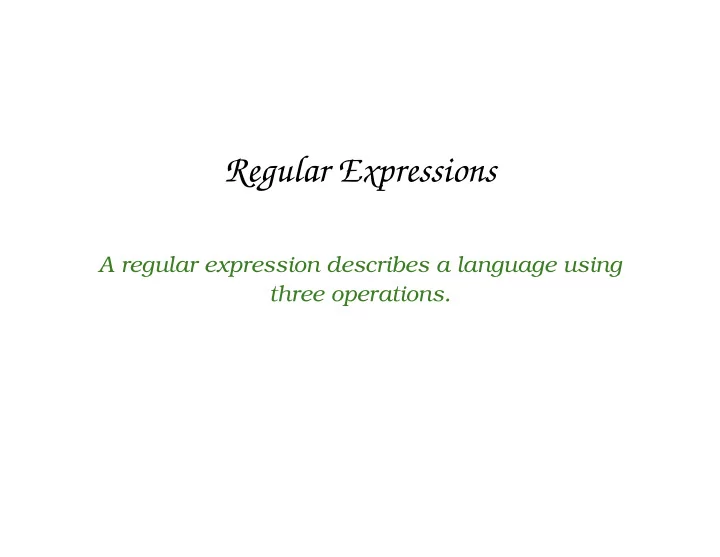

Regular Expressions A regular expression describes a language using three operations.
Regular Expressions A regular expression (RE) describes a language. It uses the three regular operations. These are called union/or , concatenation and star . Brackets ( and ) are used for grouping, just as in normal math. Goddard 2: 2
Union The symbol + means union or or . Example: 0 + 1 means either a zero or a one. Goddard 2: 3
Concatenation The concatenation of two REs is obtained by writing the one after the other. Example: ( 0 + 1 ) 0 corresponds to { 00 , 10 } . ( 0 + 1 ) ( 0 + ε ) corresponds to { 00 , 0 , 10 , 1 } . Goddard 2: 4
Star The symbol ∗ is pronounced star and means zero or more copies. Example: a ∗ corresponds to any string of a ’s: { ε, a , aa , aaa , . . . } . ( 0 + 1 ) ∗ corresponds to all binary strings. Goddard 2: 5
Example An RE for the language of all binary strings of length at least 2 that begin and end in the same symbol. Goddard 2: 6
Example An RE for the language of all binary strings of length at least 2 that begin and end in the same symbol. 0 ( 0 + 1 ) ∗ 0 + 1 ( 0 + 1 ) ∗ 1 Note precedence of regular operators: star al- ways refers to smallest piece it can, or to largest piece it can. Goddard 2: 7
Example Consider the regular expression (( 0 + 1 ) ∗ 1 + ε ) ( 00 ) ∗ 00 Goddard 2: 8
Example Consider the regular expression (( 0 + 1 ) ∗ 1 + ε ) ( 00 ) ∗ 00 This RE is for the set of all binary strings that end with an even nonzero number of 0 ’s. Note that different language to: ( 0 + 1 ) ∗ ( 00 ) ∗ 00 Goddard 2: 9
Regular Operators for Languages If one forms RE by the or of REs R and S , then result is union of R and S . If one forms RE by the concatenation of REs R and S , then the result is all strings that can be formed by taking one string from R and one string from S and concatenating. If one forms RE by taking the star of RE R , then the result is all strings that can be formed by taking any number of strings from the language of R (possibly the same, possibly different), and concatenating. Goddard 2: 10
Regular Operators Example If language L is { ma , pa } and language M is { be , bop } , then L + M is { ma , pa , be , bop } ; LM is { mabe , mabop , pabe , pabop } ; and L ∗ is { ε, ma , pa , mama , . . . , pamamapa , . . . } . Notation: If Σ is some alphabet, then Σ ∗ is the set of all strings using that alphabet. Goddard 2: 11
An RE for Decimal Numbers English: “Some digits followed maybe by a point and some more digits.” RE: ( - + ε ) D D ∗ ( ε + . D ∗ ) where D stands for a digit. Goddard 2: 12
Kleene’s Theorem Kleene’s Theorem. There is an FA for a lan- guage if and only there is an RE for the lan- guage. Proof (to come) is algorithmic. Regular language is one accepted by some FA or described by an RE. Goddard 2: 13
Applications of REs • Specify piece of programming language, e.g. real number. This allows automated produc- tion of tokenizer for identifying the pieces. • Complex search and replace. • Many UNIX commands take regular expres- sions. Goddard 2: 14
Practice Give an RE for each of the following three lan- guages: 1. All binary strings with at least one 0 2. All binary strings with at most one 0 3. All binary strings starting and ending with 0 Goddard 2: 15
Solutions to Practice 1. ( 0 + 1 ) ∗ 0 ( 0 + 1 ) ∗ 2. 1 ∗ + 1 ∗ 01 ∗ 3. 0 ( 0 + 1 ) ∗ 0 + 0 In each case several answers are possible. Goddard 2: 16
Summary A regular expression (RE) is built up from in- dividual symbols using the three Kleene opera- tors: union ( + ), concatenation, and star ( ∗ ). The star of a language is obtained by all possible ways of concatenating strings of the language, repeats allowed; the empty string is always in the star of a language. Goddard 2: 17
Recommend
More recommend